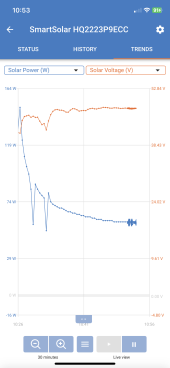So after our original plan for the house and complete off grid living has gone out the window.
We’ve opted for a smaller off grid setup for the garage/workshop.
Now due to constraints on available space, workshop side we have had to opt for smaller panels.
Current battery setup is 24v 460ah. (8 12v 115ah batteries wired in parallel series).
It will be running the led lights, beer fridge and freezer small radio and the odd power tool battery charging point.
We’ve calculated usage to be 1.3-4kw per day so rounded up to 1.5kw for extra sake.
Ideally I’d like to use the victron 24/1200 inverter paired with a pair of victron 100/20 mppt to run everything.
However I have been offered a EPEVER 40amp mppt for half the cost of the two victron units so tempting.
So really main questions are:
What wattage of solar panels would be enough to keep these batteries maintained? The fridge and freezer are the biggest draw being quite old.
With the 100/20 mppt could I put 600w of pv through each providing I don’t go above the 100v ceiling?
Would you use the pair of victron units of save a chunk for extra panels with the EPEVER 40 (100v/40a) mppt?
Cheers all in advance.
We’ve opted for a smaller off grid setup for the garage/workshop.
Now due to constraints on available space, workshop side we have had to opt for smaller panels.
Current battery setup is 24v 460ah. (8 12v 115ah batteries wired in parallel series).
It will be running the led lights, beer fridge and freezer small radio and the odd power tool battery charging point.
We’ve calculated usage to be 1.3-4kw per day so rounded up to 1.5kw for extra sake.
Ideally I’d like to use the victron 24/1200 inverter paired with a pair of victron 100/20 mppt to run everything.
However I have been offered a EPEVER 40amp mppt for half the cost of the two victron units so tempting.
So really main questions are:
What wattage of solar panels would be enough to keep these batteries maintained? The fridge and freezer are the biggest draw being quite old.
With the 100/20 mppt could I put 600w of pv through each providing I don’t go above the 100v ceiling?
Would you use the pair of victron units of save a chunk for extra panels with the EPEVER 40 (100v/40a) mppt?
Cheers all in advance.
Last edited:



